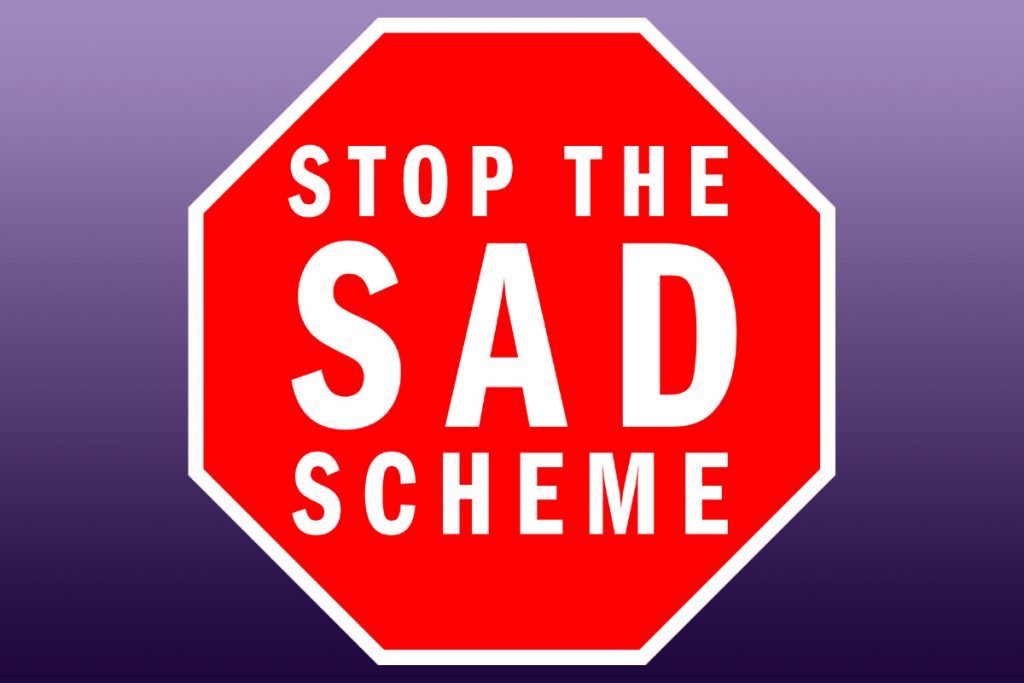Judge Ranjan Cracks Down on SAD Scheme Cases
 Judge Nicholas Ranjan of the Western District of Pennsylvania has issued a standing order titled “‘SCHEDULE A’ CASE STANDING ORDER.” I couldn’t find the order on Judge Ranjan’s website or via standard Google searches. Instead, it appeared on the docket of BUSH v. JINCHENGZHIZEGONGYINGLIANYOUXIANGONGSI, 2:2025cv00926 (W.D. Pa. complaint filed July 7, 2025), a copyright case brought by Darrell Bush. I presume Judge Ranjan intends to file the standing order on all other SAD Scheme cases that appear on his docket?
Judge Nicholas Ranjan of the Western District of Pennsylvania has issued a standing order titled “‘SCHEDULE A’ CASE STANDING ORDER.” I couldn’t find the order on Judge Ranjan’s website or via standard Google searches. Instead, it appeared on the docket of BUSH v. JINCHENGZHIZEGONGYINGLIANYOUXIANGONGSI, 2:2025cv00926 (W.D. Pa. complaint filed July 7, 2025), a copyright case brought by Darrell Bush. I presume Judge Ranjan intends to file the standing order on all other SAD Scheme cases that appear on his docket?
The Problem
The standing order starts with some policy considerations, acknowledging that “counterfeit sales appear to be a serious problem” and that IP owners need “to be able to obtain meaningful relief.” However, as a response to these problems, the SAD Scheme “has led to gradual and oftentimes bizarre modifications from how normal litigation is conducted.” The standing order gives some examples of those “bizarre” deviations:
- requested exceptions to the Hague convention’s service and translation services (including email service) that are “almost never even made in other cases against foreign defendants.”
- ex parte TROs. “This type of request is also unheard of in most civil cases. Certainly, in some non-Schedule A IP cases, plaintiffs move for an asset freeze. But this type of remedy isn’t ordered ex parte and before there is even any evidence that the defendant has sought to move assets; and to grant such relief, there usually has to be discovery and a hearing, so that the asset freeze is narrowly tailored to the amount needed to satisfy a disgorgement award.” In a footnote, the order continues: “It appears that the reason for the ex parte TRO motion in Schedule A cases is to generate settlement leverage, as settlements appear to be reached based on a percentage of the frozen accounts.”
- jurisdiction and joinder. “Joining often hundreds of defendants on a Schedule, particularly in a case involving a number of disparate marks or copyrights, is likely to run afoul of Rule 20. And suing defendants without a sound basis as to their contacts into the forum/personal jurisdiction runs the risk of violating these defendants’ due process rights.” In a footnote, the order continues: “a defendant who might contest personal jurisdiction might not have the incentive to do so, because by the time it appears in the case, there is already a TRO asset freeze.”
The standing order summarizes (emphasis added): “many of the modifications to the traditional rules that have developed in this area of the law are extraordinary exceptions to the normal rules, and appear to have been simply a creature of the economics of the litigation.” 💥
The Solution
The standing order issues several instructions designed to curb SAD Scheme abuses:
- Joinder: “each complaint shall consist of a single defendant or group of defendants acting under the same operator….If the marks, copyrights, or patents at issue are disparate and unrelated, then the complaints must be divided to include only related IP.” The order signals that the judge may be open to case consolidation after personal jurisdiction has been established.
- Jurisdiction: The standing order says “personal jurisdiction will be a defendant-specific inquiry, which examines the particular defendant’s sales of the allegedly infringing product into the forum state.” Thus, “the complaint must plausibly plead allegations of personal jurisdiction, including contacts with the forum if specific jurisdiction is invoked.” The order continues: “The law is well-settled that simply being an online seller on Amazon isn’t enough. And the law is also well-settled that that plaintiff cannot create personal jurisdiction by ordering a product to be shipped to the forum.” Unfortunately, jurisdiction law in the Western District of Pennsylvania apparently diverges from the Northern District of Illinois, where courts have routinely accepted jurisdiction based on the availability of online storefronts or successful test buys. In a foptnote, the order tells plaintiffs that it’s their problem if they can’t get the necessary facts to establish jurisdiction before filing their complaint, but “if a plaintiff meets Rule 11’s threshold requirement, the Court will certainly consider allowing jurisdictional discovery, on a case-by-case basis.”
- Service: “the Court will not, as a matter of course, allow a plaintiff to dispense with ordinary service requirements, including foreign service requirements under the Hague Convention. There needs to be a particularized showing—which will likely be case specific and defendant specific—before alternate service is authorized…Any motions for alternate service should explain what efforts have been made to discover each defendant’s domicile and to effectuate service by usual means (including what efforts were undertaken to determine the address of each defendant and the validity of the address) and whether the form of alternate service requested is permitted by the Hague Convention given each defendant’s domicile (and the factual basis for this)… to save costs, plaintiffs can always email defendants the waiver-of-service forms, which would obviate the need for Hague Convention service.” (Ha ha, most of those emailed forms will go to dead email addresses or into spam folders. Misdirected or ignored email is one of the reasons IP owners love to serve the complaint service by email).
- Ex parte TROs: “the Court does not intend, as a matter of course, to grant ex parte TRO motions….the Court will not grant TRO and preliminary-injunction motions based on conclusory statements. The Court will not grant any TRO motions where there is not a sound basis that personal jurisdiction exists as to the defendant. The Court is also unlikely to grant any TRO motion to freeze online accounts absent some evidence that the defendant has transferred or is transferring assets to avoid judgment in the specific case, and also after a specific showing linking the amount of assets to the amount of disgorgement at issue.”
- Sealing. “the Court is unlikely to seal any filings.”
- Disclosures of Other Cases. Plaintiff’s counsel must declare “any pending cases brought by the plaintiff(s) against any of the named defendants prior to this suit.” (The order later says that includes dismissed cases, but I’m not sure how cases simultaneously can be pending and dismissed. It appears the judge is aware of how some plaintiffs judge-shop by dismissing cases in front of skeptical judges, only to refile the same cases against the same defendants hoping for a more favorable draw).
Implications
Judge Ranjan’s standing order comprehensively rejects the SAD Scheme. The order’s remedial steps undermine many of the SAD Scheme’s standard abuses: No wrongful joinder of unrelated defendants. No generalized non-defendant-specific assertions of personal jurisdiction. No service by email. No asset freezes without evidence that the defendant is trying to move assets. No sealed complaints. Take away those procedural tools, and what’s left isn’t a SAD Scheme case any more–it’s a standard IP enforcement action, which is exactly what the rightsowners are trying to avoid.
In June, Judge Kness dropped a bombshell blanket hold on the SAD Scheme cases on his docket. He said he would reassess if:
(1) ex parte proceedings are appropriate in these types of cases;
(2) the routine sealing of parts or all of the docket is appropriate;
(3) the routine granting of temporary restraining orders on an ex parte basis is a sound exercise of judicial discretion;
(4) the routine granting of prejudgment asset restraints is a sound exercise of judicial discretion; and
(5) the mass joinder of defendants is appropriate under the circumstances typically present in Schedule A cases.
Judge Kness, located in the Northern District of Illinois, surely has more SAD Scheme cases on his docket than Judge Ranjan in the Western District of Pennsylvania. As a result, any change in Judge Kness’ approach will have a much bigger impact on SAD Scheme litigation than Judge Ranjan’s standing order. But we’re still waiting to hear the results of Judge Kness’ reassessment. In the interim, Judge Ranjan has taken concrete demonstrable steps against the SAD Scheme in his courtroom. I hope other judges (including Judge Kness) pay close attention to Judge Ranjan’s move. We inch ever closer to the end of the SAD Scheme….and its inevitable evolution/mutation into some new abusive enforcement horror.
[Maybe not for nothing: both Judge Kness and Judge Ranjan are Trump 1.0 appointees. While TAFS judges sometimes apply the rule of law in dubious and not-credible ways, some of them also believe very deeply in the rule of law–which makes the SAD Scheme abuses an affront to their sensibilities. Also, as a broad stereotype, more recently appointed judges (including Biden appointees) have shown greater skepticism towards SAD Scheme cases than the OG judges.]
* * *
For doing exactly what my Paul McCartney meme requests, I hereby award Judge Ranjan the Technology & Marketing Law Blog Judge of the Day award. 🙏
Case Citation: In re: “SCHEDULE A” CASES, 2025 WL 1906814 (W.D. Pa. July 10, 2025).
BONUS: In June, I gave four talks about the SAD Scheme in China (in Ningbo, Hangzhou, Shenzhen, and Beijing–see my photo album). My freshly updated slide deck (including new empirical data) from my talk at Peking University Shenzhen.
Prior Blog Posts on the SAD Scheme
- Because the SAD Scheme Disregards Due Process, Errors Inevitably Ensue–Modlily v. Funlingo
- SAD Scheme-Style Case Falls Apart When the Defendant Appears in Court—King Spider v. Pandabuy
- Serial Copyright Plaintiff Lacks Standing to Enforce Third-Party Copyrights–Viral DRM v 7News
- Another N.D. Ill. Judge Balks at SAD Scheme Joinder–Zaful v. Schedule A Defendants
- Judge Rejects SAD Scheme Joinder–Toyota v. Schedule A Defendants
- Another Judge Balks at SAD Scheme Joinder–Xie v. Annex A
- Will Judges Become More Skeptical of Joinder in SAD Scheme Cases?–Dongguan Juyuan v. Schedule A
- SAD Scheme Leads to Another Massively Disproportionate Asset Freeze–Powell v. Schedule A
- Misjoinder Dooms SAD Scheme Patent Case–Wang v. Schedule A Defendants
- Judge Hammers SEC for Lying to Get an Ex Parte TRO–SEC v. Digital Licensing
- Judge Reconsiders SAD Scheme Ruling Against Online Marketplaces–Squishmallows v. Alibaba
- N.D. Cal. Judge Pushes Back on Copyright SAD Scheme Cases–Viral DRM v. YouTube Schedule A Defendants
- A Judge Enumerates a SAD Scheme Plaintiff’s Multiple Abuses, But Still Won’t Award Sanctions–Jiangsu Huari Webbing Leather v. Schedule A Defendants
- Why Online Marketplaces Don’t Do More to Combat the SAD Scheme–Squishmallows v. Alibaba
- SAD Scheme Cases Are Always Troubling–Betty’s Best v. Schedule A Defendants
- Judge Pushes Back on SAD Scheme Sealing Requests
- Roblox Sanctioned for SAD Scheme Abuse–Roblox v. Schedule A Defendants
- Now Available: the Published Version of My SAD Scheme Article
- In a SAD Scheme Case, Court Rejects Injunction Over “Emoji” Trademark
- Schedule A (SAD Scheme) Plaintiff Sanctioned for “Fraud on the Court”–Xped v. Respect the Look
- My Comments to the USPTO About the SAD Scheme and Anticounterfeiting/Antipiracy Efforts
- My New Article on Abusive “Schedule A” IP Lawsuits Will Likely Leave You Angry
- If the Word “Emoji” is a Protectable Trademark, What Happens Next?–Emoji GmbH v. Schedule A Defendants
- My Declaration Identifying Emoji Co. GmbH as a Possible Trademark Troll


